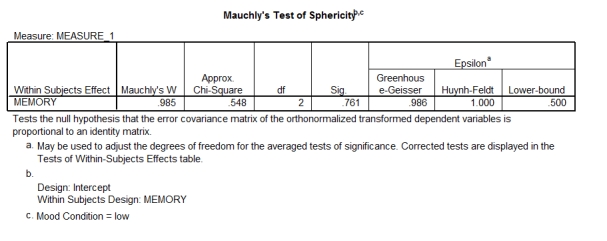A nutritionist conducted an experiment on memory for dreams. She wanted to test whether it really was true that eating cheese before going to bed made you have bad dreams. Over three nights, the nutritionist fed people different foods before bed. On one night they had nothing to eat, a second night they had a big plate of cheese, and the third night they had another dairy product, milk, before bed. All people were given all foods at some point over the three nights. The nutritionist measured heart rate during dreams as an index of distress. Which statement is the correct way to report these results? 

A) There was no significant effect of food on the distress caused by memories, F(2, 76) = 2.27, p = .11.
B) There was a significant effect of food on the distress caused by memories, F(2, 76) = 2.27, p < .05.
C) There was a significant effect of food on the distress caused by memories, F(1.97, 74.90) = 2.27.
D) There was no significant effect of food on the distress caused by memories, F(1.97, 74.90) = 2.27.
Correct Answer:
Verified
Q8: When conducting a repeated-measures ANOVA which of
Q9: What is Repeated-measures factorial design?
A)An experiment, which
Q10: The results of a one-way repeated-measures ANOVA
Q11: When entering data for a repeated-measures design
Q12: Imagine we were interested in the
Q14: Imagine we were interested in the effect
Q15: Imagine we were interested in the
Q16: Which of the following regarding the assumption
Q17: Which of the following statements is false?
Q18: Imagine we were interested in the effect
Unlock this Answer For Free Now!
View this answer and more for free by performing one of the following actions

Scan the QR code to install the App and get 2 free unlocks

Unlock quizzes for free by uploading documents